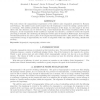Free Online Productivity Tools
i2Speak
i2Symbol
i2OCR
iTex2Img
iWeb2Print
iWeb2Shot
i2Type
iPdf2Split
iPdf2Merge
i2Bopomofo
i2Arabic
i2Style
i2Image
i2PDF
iLatex2Rtf
Sci2ools
SSWMC
2004
2004
Fast additive noise steganalysis
This work reduces the computational requirements of the additive noise steganalysis presented by Harmsen and Pearlman. The additive noise model assumes that the stegoimage is created by adding a pseudo-noise to a coverimage. This addition predictably alters the joint histogram of the image. In color images it has been shown that this alteration can be detected using a three-dimensional Fast Fourier Transform (FFT) of the histogram. As the computation of this transform is typically very intensive, a method to reduce the required processing is desirable. By considering the histogram between pairs of channels in RGB images, three separate two-dimensional FFTs are used in place of the original three-dimensional FFT. This method is shown to offer computational savings of approximately two orders of magnitude while only slightly decreasing classification accuracy.
Additive Noise | Additive Noise Model | Additive Noise Steganalysis | Security Privacy | SSWMC 2004 |
| Added | 31 Oct 2010 |
| Updated | 31 Oct 2010 |
| Type | Conference |
| Year | 2004 |
| Where | SSWMC |
| Authors | Jeremiah J. Harmsen, Kevin D. Bowers, William A. Pearlman |
Comments (0)

